Murals of Oklahoma
George Biddle a old classmate of President Roosevelt wrote a letter to him dated May 9, 1933 that noted the achievements of Mexican muralists such as Diego Rivera and suggested that young American artist should be able to express American ideas of history and culture on public buildings and walls of America. Although not a new conscept to the president it did however strike a cord with him and the president then convince the New Deal officials to accept a program that would put the artist back to work as well as “bring art back to the common man” [6]
In 2003-2004 a Thematic survey was conducted by the Department of Geography, Oklahoma State University. Because of this survey it was found that there was 37 art projects from the New Deal Area. The following table shows those 37 art projects and others that were significant to the New Deal.
| City | Building | Address | Art Work | |
| 1 | Tahlequah | Cherokee Female Seminary | 1. Kiowa Buffalo Hunt. 2. Kiowa War Dance. | |
| 2 | Enid | Garfield County Courthouse | 114 W. Broadway Street, Enid | Mural Cycle: Trail Blazers of the Cherokee Strip; The Hunting Trail; The Exporer’s Trail; The Cattle Trails; The Commerce Trail; The Homemaker’s Trail; The Rancher’s Trail. |
| 3 | Chickasha | Health and Physical Education Building | 1700 Blocks of S. 17th Street, Chickasha | Mural Cycle: Buffalo Dancers; Moving Camp – Room 201. Indian Spear Dancer;Dancer with Headdress – Room 202. Drummer (Destroyed); Thunderbird. |
| 4 | Oklahoma City | Oklahoma Supreme Court House | 2100 N. Lincoln Blvd, Oklahoma City | 1. Choctaw 1843 – Spencer Asah. (1937) 2. Secotan 1650 – Spencer Asah. (1937) 3. Kiowa 1920 – Monroe Tsatoke. (1937) 4. Cheyenne 1832 – Monroe Tsatoke. (1937) 5. Kiowa 1832 – Monroe Tsatoke. (1937) 6. Osage 1839 – Monroe Tsatoke. (1937) 7. Kiowa 1900– Monroe Tsatoke. (1937) 8,9. Sheild Designs – Monroe Tsatoke. (1937) 10. Comanche 1880 – Monroe Tsatoke. (1937) |
| 5 | Anadarko | US Post Office | 120 S. First Street, Anadarko | Mural Cycle by Stephen Mopope (1937) |
| 6 | Cordell | US Post Office | 121 E. First Street, Cordell | The Scene Changes by Ila McAfee Turner (1938) |
| 7 | Sayre | US Post Office | 201 N. Fourth Street | The Opening of the Cheyenne and Arapaho Country by Vance Kirkland (1940) |
| 8 | Vinita | US Post Office/Courthouse | 120 E. Illinois Ave. | Cherokee History by Randall Davey (1941) |
| 9 | Nowata | US Post Office | 109 N. Pine Street | The Rainbow Trail by Woody Crumbo (1943) |
| 10. | Okemah | US Post Office | 418 W. Broadway Street | Grand Council of 1842 by Walter Richard West (1941) |
| 11 | Watonga | US Post Office | 121 N. Noble Ave | Roman Nose Canyon by Edith Mahier (1941) |
| 12 | Weatherford | US Post Office | 107 E. Franklin Ave | Terminus of the Railroad by Oscar E. Berninghaus (1939) |
| 13 | Norman | Jacobson Hall, OU | 550 Parrinton Oval | Thirty Carved Oak Panels Illustrating Life and Art Styles from the Cave Man through the Steel Worker by Derald Swineford, Anita Furray, Margaret Giles, and Paul McBride (1934-45) |
| 14 | Oklahoma City | Wilson Elementary School | 2215 N. Walker Ave | Nursery Rhyme Characters by Audre Yates (1934). The Circus by Audre Yates (1934). Dancer attributed to Herbert White Buffalo (1940). Woman Making Baskets by Acee Blue Eagle (n.d.). Knife Dancer by Acee Blue Eagle (n.d.). Ready for the Hunt by Acee Blue Eagle (n.d.). |
| 15 | Norman | Adams Hall, OU | 307 W. Brooks Street | 8 Panels originally produced. |
| 16 | Seminole | US Post Office | 120 E. Oak Ave | Seminole Indian Village Scene by Acee Blue Eagle (1939) |
| 17 | Coalgate | US Post Office | 38 N. Main Street | Women Making Pishafa by Acee Blue Eagle (1942) |
| 18 | Marietta | US Post Office | 118 W. Main Street | Chickasaw Family Making Pah Sho Fah by Soloman McCombs (1942) |
| 19 | Drumright | US Post Office | 118 N. Ohio Ave | Oklahoma Land Rush by Frank Weathers Long (1941) |
| 20 | Madill | US Post Office | 223 W. Lillie Blvd | Prairie Fire by Ethel Magafan (1940) |
| 21 | Stilwell | US Post Office | 16 S. Second Street | Cherokee Indian Faming and Animal Husbandry by Olga Mohr (1942) |
| 22 | Sulphur | US Post Office | 1100 W. Second Street | The Romance of the Mail / The Mail in the Old Cattle Country by Albert Turner Reid (1939) |
| 23 | Pawhuska | US Post Office | 137 E. Sixth Street | Osages (Treaties – Osage Indians) by Olive Rush (1938) |
| 24 | Waurika | US Post Office | 121 W. Broadway Ave | Canadian Honkers by Theodore Van Soelen (1939) |
| 25 | Hollis | US Post Office | 120 N. Second Street | Mapping the trail by Lloyd Lozes Goff (1941) |
| 26 | Marlow | US Post Office | 320 W. Main Street | Cattle Days by Lew E. Davis (1942) |
| 27 | Wewoka | US Post Office | 115 W. Second Street | Historical Background of Wewoka by Marjorie Rowland Clarke (1941) |
| 28 | Purcell | US Post Office | 228 W. Main Street | The Round-up by Frederick E. Conway (1940) |
| 29 | Poteau | US Post Office | 115 N. Witte Street | Cotton by Joan Cunningham (1940) |
| 30 | Muskogee | McCombs Hall, Bacone College | 2299 Old Bacone Road | Buffalo Hunt by Stephen Mopope (1934). War Dance by Stephen Mopope (1934). Were moved from original location) |
| 31 | Muskogee | Palmer Center, Bacone College | Indian Pictorial Writing by Acee Blue Eagle (1937). Sequoyah Teaching His Alphabet by Acee Blue Eagle (1937). No evidence exists that these are New Deal Art and the Current are reproductions. | |
| 32 | Tulsa | Berryhill Elementary School | 3128 S. 63rd Street | Ichabod Crane by Mary McCray (1934). Uncle Remus by Mary McCray (1934). |
| 33 | Clinton | City Hall | 415 Gary Blvd | Race for Land by Loren N. Mozley (1938). (moved from original location of Us Post Office). |
| 34 | Hugo | Administrative Offices, Hugo Public Schools | 208 N. Second Street | The Red Man Of Oklahoma Sees the First Stage Coach by Joseph A. Fleck (1937). Move from original location of post office. |
| 35 | Perry | Cherokee Strip Museum | 2617 W. Fir Street | Range Branding Down by the Big Tank by Thomas M. Stell, jr. (1941). moved from original location of post office. |
| 36 | Edmond | City Hall | 100 E. First Street | Pre-Settlement Days by Ila McAfee Turner (1939) moved from it’s original location of post office |
| 37 | Idabel | Post Office | 201 E. Central Ave | The Last Home of the Choctaw Nation by H. Louis Freund (1940) moved to new post office (not confirmed) |
| 38 | Tahlequah | US Post Office | 1101 S. Muskogee Ave | Choctaw Ball-Play by Manuel Bromberg (1939) |
| 39 | Goodwell | No Man’s Land Historical Museum | 207 W. Sewell Street | Harvest by Jay Risling (1939) |
| 40 | Yukon | US Post Office | 900 Garth Brooks Blvd | The Run, April 22, 1889 by Dahlov Ipcar (1941) |
| 41 | Stillwater | US Post Office | 720 South Husband Street | Early Days in Payne County by Grace L. Hamilton (1963). Although not directly New Deal art, it may represent an enduring legacy of it [2]. |
| 42 | Weatherford | Al Harris Library | 809 N. Custer Street | Kiowa Indian Dancers by Stephen Mopope (1931). Although not commisioned by New Deal art project it represents Stephen Mopope’s earlier work. |
| 43 | Oklahoma City | Oklahoma Museum of History (storage) | Indian Friendship by James Auchiah (1934). Moved from original location of Information Room of the Office of the Superintendent of the Five Civilized Tribes Agency Federal Building, Muskogee. | |
| 44 | Claremore | Post Office (New) | Will Rogers by Randall Davey in 1939. |
Sources:
- National Archives – https://catalog.archives.gov/id/70170110
- Thematic Survey of New Deal Era Public Art in Oklahoma 2003-2004.
- New Deal Art: The Oklahoma Experience 1933-1943 by Barbara Kerr Scott Ph.D and Sally Bradstreet Soelle Ph.D.
- https://www.wikiwand.com/en/List_of_United_States_post_office_murals
- 1934: A New Deal for Artists Guide for Educators
- Documentation of Mural Building 4720 U.S. Army Field Artillery Center, Fort Sill Military Reservation, Oklahoma, by Joe C. Freeman, 1995.
- https://www.historynet.com/the-kiowa-five/
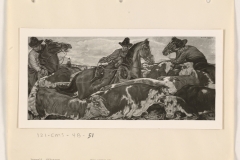
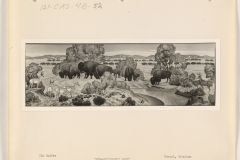
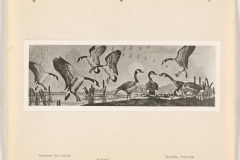
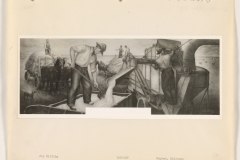
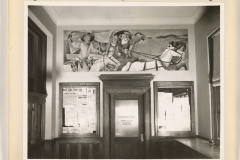
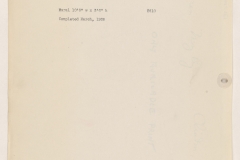
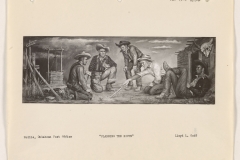
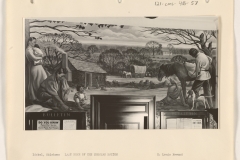

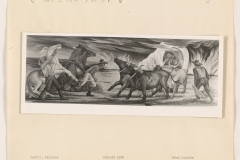
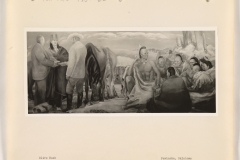
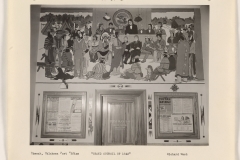
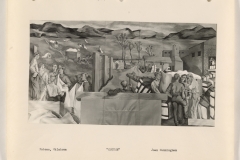
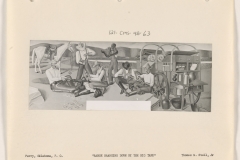
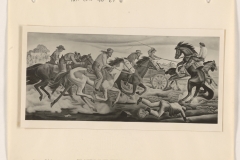
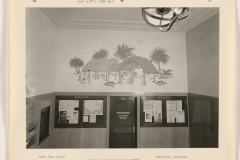
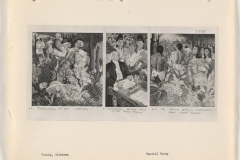
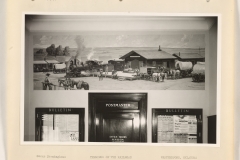
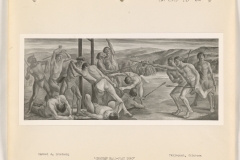
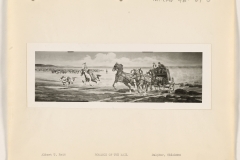
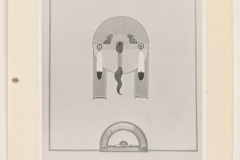
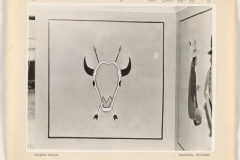
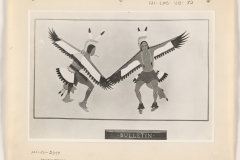
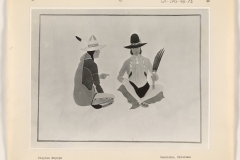



Leave a Reply